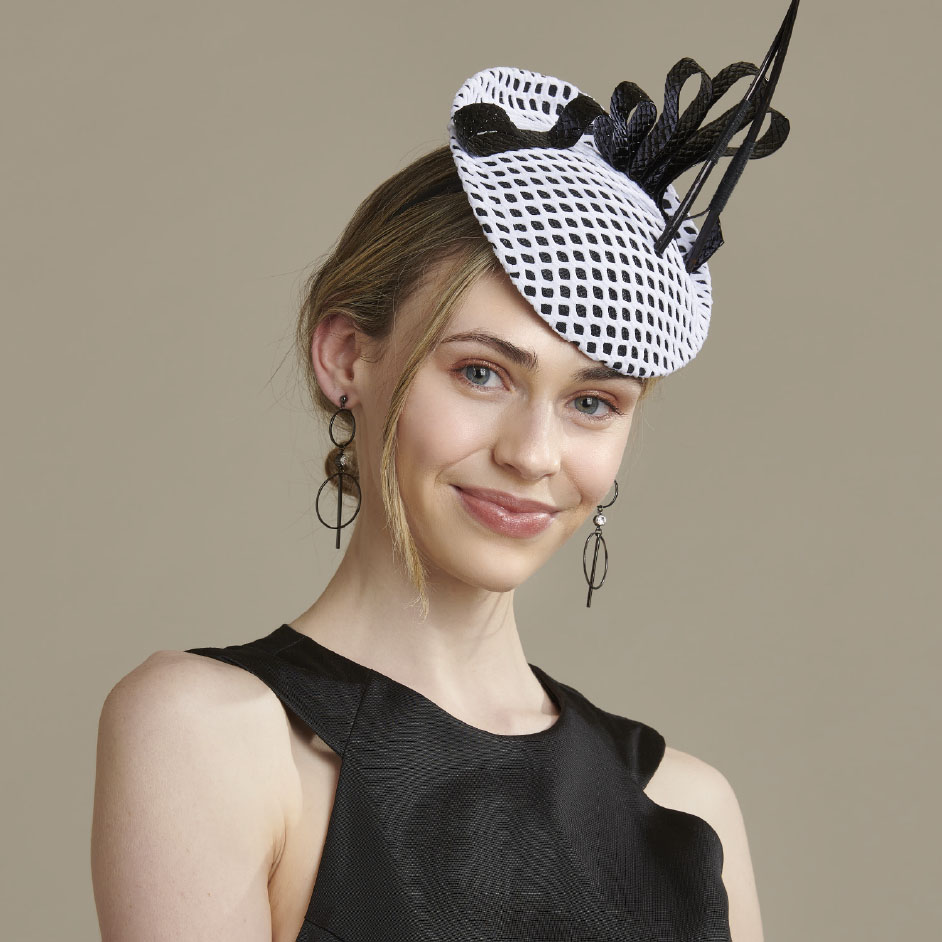 | ||
| Your browser is not supported. | ||
|
Please browse our site using any of the following options:
| ||
BLACK & WHITE HEADPIECE

LEVEL: EASY
WHAT YOU'LL NEED:
- Maria George Paper Base on Headband (Black)
- White stretch fabric for overlay of the base. 30cms of open weave fabric cut on the bias which could include any open weave stretch fabric including lace available at Spotlight
- Racello millinery braid (which is a shiney braid but you could substitute for Simplicity Black Faux leather braid for both widths. I used two widths in black. The narrow one 30cms for the base binding underneath the base to over the overlay fabric and the wider one 1.1M approx. for the wave trim
- Narrow white braid - Simplicity mini gimp or alternative
- 1 Black quill and 1 black duck feather, wired as specified below. A few cheap black feathers to randomly cut and shape to cover your stitching and joins
- White millinery wire or Vivaldi floristry wire stems (pack of 35, 22 gauge) to support the feathers - 20cms x 2. If the wire coating is white you will need a permanent black marker to colour the wire
- 1 Acrylic black flower with diamante centre or alternative
- Fine needles
- Black and white strong thread
- 450 Clear glue, quick drying
- Hair wand
- Wire cutters
INSTRUCTIONS
Step 1 - Measure the outer circumference of the base and cut a piece of the white fabric 2.5cm wider than the base measurement all round.
Step 2 - Gently stretch so there are no creases, pin into place and stitch using white thread in and out of the base at the edge from back to front using small invisible stitches. Trim underneath 1 centimetre in from the edge.
Step 3 - Fold in the edge of one end of the racello braid and glue all around the edge, proceeding in 5 cm intervals to ensure the glue dries properly. When you meet at the centre back join also fold this end under as well and the join should butt together.
Step 4 - The racello braid used for the underside of the base is too narrow to completely cover the existing gross grain ribbon edge binding as intended, so use an additional narrow white braid, stitched on all around beneath the black braid. This gives more definition and contrast to the underside brim. The total width of the underside braids was 1.5cm.
Step 5 - Cover the joins of both braids at the centre back with a cut feather, just lightly glued on and covered with an acrylic flower, also glued on.
Step 6 - Trim for the top of the headpiece. I decided on a varied height wave to give the piece some softness, to complement the curled quill and shaped duck feather. Vary the loop sizes and stitch in place. Cut the ends at a 45-degree angle to finish. You may want to apply a very small amount of glue to the ends to stop any fraying. This braid can also be ironed out with your hair wand. It is a sensitive product so be careful not to overheat or it will melt.
Step 7 - Quills generally are purchased straight. To curl the quill, firstly place in a small tub/sink of hot water for approx. 10-15mins. Pat dry and using your hair curling iron, clamp the tip in the wand then gently wind around the wand from the base of the wand outwards winding 3-4 times depending on the curls required. If the quill sort of bends instead of being a smooth curl, then go back and sort of tease the spine bit by bit until its "ironed out." Hold for approx. 30secs then release and you have a lovely, curled quill. Beware the wand can be hot! If you don't like the curl, simply re wind. Don't let the quill dry out too much or it will break. You can extend the quill by gently pulling the tip upwards while it is still warm and it will spring back into place. Set aside to be wired to the hat base.
Step 8 - Take your duck feather and completely de nude one side of the feather by pulling the veins down from the top to the bottom of the spine. Use a permanent black marker to colour in the white part of the spine that may be exposed.
Step 9 - Remove any fluffy bits on the spine. Shape the feather as required. I have cut in a soft curve from the tip to the base. Rest the feather against your non dominant hand to stabilise and trim with sharp scissors for the desired shape. Set aside to be wired. Wired feathers are used to look like they are floating, and they also give extra height rather than just being simply stitched onto the base.
Step 10 - Technique for wiring a feather. Measure off approx. 20cms of wire for each feather, or use 1 piece of pre-cut floristry wire. Use approx. a 2.5metre long strong thread for winding each feather. This sounds a lot and don't get tangled, but better to be safe than sorry and you run out of thread midstream!"
Step 11 - Start by lightly glueing the thread to the spine about 1/2 way up the spine with the end pointing to the base of the feather. Place the wire over the thread. Wind the thread gently around approx. 10 times first in a criss cross motion and then firmly wrap moving up the spine. Make sure the wrapped threads are close together. You can gently manoeuvre these threads together if there are small gaps. Wind to just a little past the end of the wire.
Step 12 - Thread a needle and come back through the winding, make a knot after each time you go through the threads. Do this a few times until you end up at the top of the winding, knot and cut thread flush with the winded thread.
Step 13 - Bend the wire from the base of the winding outwards at about 30 degrees. Decide on where you want to place the feathers. Gently poke a similar size needle to the dimension of the wire through your base and insert the wire. The wire on my piece on the outer side of the base is about 2.5cm. Bend the wire on the inside of the base, cut off the excess of the wire with wire cutters and then bend into a small U shape, about the size of a ten-cent piece. This will stabilise the wire and the feather.
Step 14 - Use invisible stitches to attach the U wire to the base. Multiple stiches close together over and under each side of the wire. You may wish to cover this with a small feather, or small flower petal you have lying around...just anything that won't fray. Or simply colour with your marker if your stitching is neat!
Tip - Especially useful on headpieces that are black.
Commercially made millinery pieces use headbands that colour match the base of the headpiece. For this project I would change the black headband to match your hair colour. Slip the headband out of the elastic. Choose an ivory headband and colour using a permanent marker to get as close to your hair colour as possible. Reinsert your new headband and it's made for you by you.




